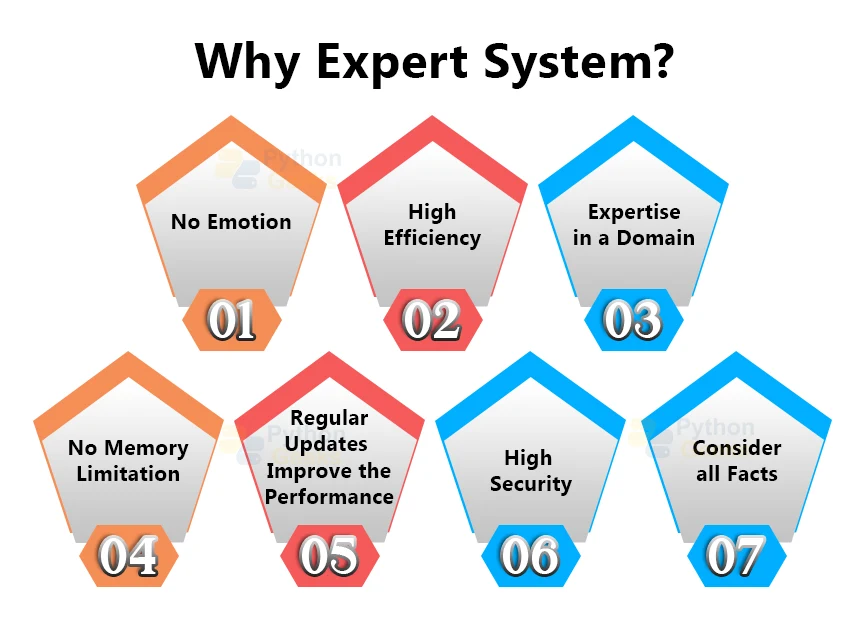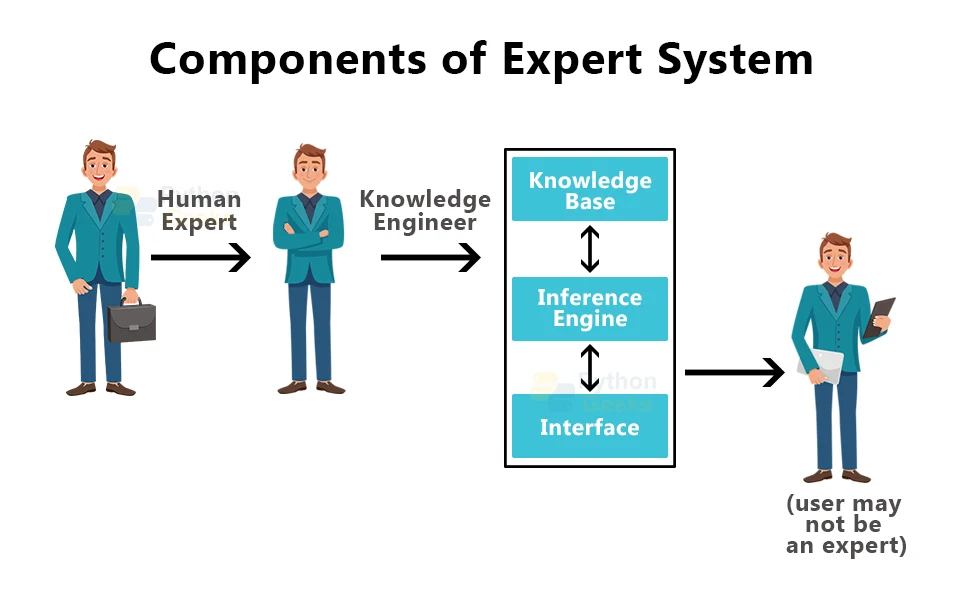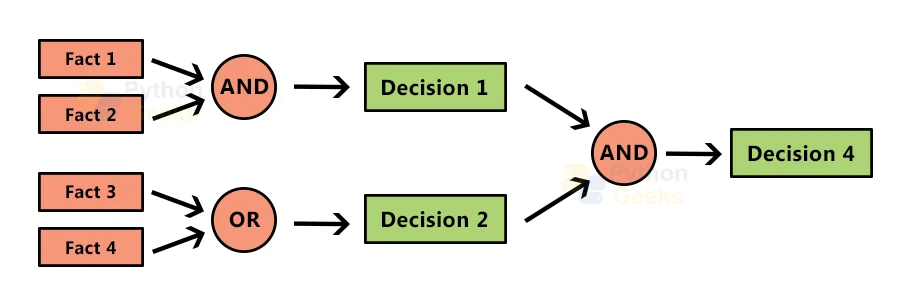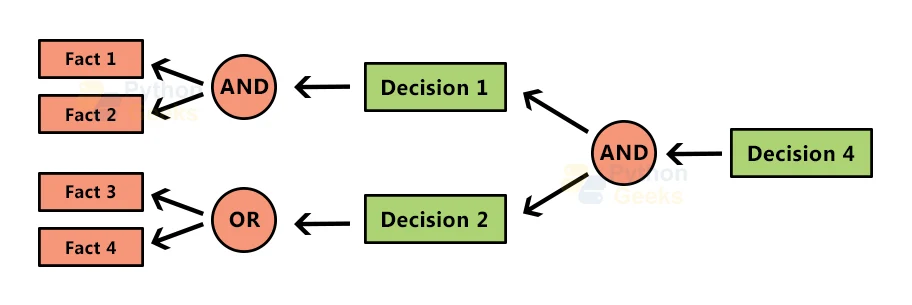Expert Systems in AI
FREE Online Courses: Elevate Your Skills, Zero Cost Attached - Enroll Now!
As businesses become more familiar with the terms artificial intelligence, machine learning, and big data in 2017, 2018 will be the year when they start planning their implementation strategies.
The lack of understanding, resources, and the enormous gap between research and practical artificial intelligence use are the key challenges preventing firms from implementing AI. Artificial intelligence technology, when properly integrated, can help your firm prepare for new revenue sources.
It is critical to understand all of the key components when preparing for artificial intelligence. This article will discuss expert systems and provide instances of modern expert systems.
What is an Expert System?
In artificial intelligence, an expert system is a computer system that simulates the decision-making abilities of a human expert. Expert systems, rather than using traditional procedural code, are supposed to handle complicated issues by reasoning through bodies of knowledge, which are primarily represented as if-then rules.
Expert systems specialize in a single problem domain, such as medicine, science, or engineering. A knowledge base is a collection of acquired experience that has been loaded and tested into the system by an expert. Expert systems, like other artificial intelligence systems, can have their knowledge augmented by adding to the knowledge base or adding to the rules. The more experience that is entered into the expert system, the better the system’s performance will be.
Expert Systems in AI: A Brief History
The history of expert systems begins in the 1940s, roughly simultaneously with the advent of the modern computer, when the first digital programmable computers appeared.
It wasn’t long before scientists began to consider the possibilities of these new technologies. What if they could learn to make decisions as humans do? What if they had the ability to “think” like humans?
Officially, the history of expert systems begins in 1965. The Stanford Heuristic Programming Project officially introduced the technology at this time. The project was led by Edward Feigenbaum, known as the “Father of Expert Systems.”
MYCIN and Dendral, two early expert systems, were both worked on by Edward Feigenbaum.
Dendral was an expert system that specialized in chemical compound analysis and identification. It is commonly regarded as the world’s first expert system.
Dendral was the source of MYCIN. It was yet another expert system, this one aimed at recognizing microorganisms that cause diseases and prescribing drugs.
These systems didn’t aim to be intelligent in the way that humans do. They weren’t problem solvers in general. Rather, they concentrated on a small (but comprehensive) base of knowledge. As a result, they were one of the earliest effective AI software attempts. That is devices that appeared to ‘think’ and analyze data.
What is the purpose of the Expert System?
1. No memory constraints
It can store and memorize as much data as it needs at the time of application. However, there are inherent limitations to memorizing everything at all times for human professionals.
2. High Efficiency
When the knowledge base is updated with the correct information, it produces a highly efficient output that a human would not be able to produce.
3. High security
To resolve any query, these systems give high security.
Takes into account all of the facts: To answer each inquiry, it examines and analyses all available information before returning a result.
However, it is feasible that a human expert will overlook some information for any reason.
4. Updates on a regular basis increase performance
If there is a problem with the results supplied by expert systems, we can improve the system’s performance by upgrading the knowledge base on a regular basis.
AI Expert Systems Instances
1. MYCIN
MYCIN is one of the oldest expert systems on the planet. It was built on the backward chaining principle and was capable of detecting infection-causing microorganisms.
MYCIN, in addition to other acne therapies, cures some bacterial infections and reduces acne. It protects persons who are allergic to penicillin antibiotics and have a history of rheumatic disease, congenital heart disease, or another acquired valvular heart ailment.
2. DENDRAL
An expert system that uses spectrographic data to determine the structure of a molecule. Its main goal was to look at how scientists generate hypotheses and find new things.
DENDRAL, a software program that automates organic chemists’ decision-making and problem-solving behavior, is believed to be the principal expert system.
3. PXDES
Pneumoconiosis X-Ray Diagnosis Expert System is an expert system that determines which stage of lung cancer a patient is in. The shadow is used to determine the kind and severity of cancer.
4. CaDet
The CaDet expert system is a cancer detection tool that can detect cancer in its early stages.
5. R1/XCON
It might choose specific software to create the computer system the user desires.
6. DXplain
Based on the information presented, this expert system was capable of diagnosing a variety of disorders in a patient.
DXplain gives information and, if applicable, clinical signs for uncommon or atypical diseases.
Expert System Capabilities
- Expert systems are capable of providing advice.
- guiding and supporting a human in making decisions
- Demonstrating how to come up with a solution
- Diagnosing \sExplaining
- Input interpretation
- Predicting outcomes
- Justification for your conclusion
Alternative solutions to a problem are suggested. They’re not capable of
- Substituting artificial intelligence for human decision-makers
- Having the ability to think and act like a person
- Producing reliable results with a limited knowledge base
- Developing their own expertise
Expert System Characteristics
1. High Efficiency and Accuracy
The expert system provides high efficiency and accuracy when tackling any type of complex problem in a specified domain.
2. Understandable
It answers in a way that the user can easily comprehend. It can both take and produce human-language input and output.
3. Reliable
It is really dependable in terms of producing an efficient and accurate result.
4. Highly responsive
ES returns the answer to any sophisticated query in a matter of seconds.
5. Right on Time Reaction
In Artificial Intelligence, an Expert System communicates with the user in a very reasonable amount of time. The overall time must be less than an expert’s time to find the most precise solution to the identical problem.
Components of Expert System
1. User Interface
The most important aspect of the Expert System Software is the user interface. This component parses the user’s query and sends it to the inference engine in a legible format. The user is then presented with the results. To put it another way, it’s a user interface that allows them to communicate with an expert system.
The user interface (UI) is the area that facilitates communication between the framework and its users. It’s the same thing as your computer desktop or your phone’s home screen.
2. Inference Engine
The Inference Engine is the brain underlying the user interface. It provides a predetermined set of rules for dealing with a certain problem, as well as references to material from the Knowledge Base.
When attempting to respond to the client’s request, it picks which realities and rules to apply. The Inference Engine allows you to think about the data in the database.
It also aids in deducing the problem in order to find a solution. This section is also useful for finishing touches.
Inference engines are divided into two types:
a. Deterministic Inference Engine
In this form of an inference engine, the conclusions are presumed to be correct. It is founded on facts and regulations.
b. Probabilistic Inference Engine
This sort of inference engine is based on probability and contains uncertainty in findings.
The following modes are used by the inference engine to generate solutions:
Forward Chaining
This method starts with known facts and rules, then applies inference rules to add their conclusions to the known facts.
This method was basically used to predict the likely outcome in the future. This technique uses expert systems to determine the most likely outcome given the provided inputs and conditions.
For instance, Prediction of share market status as an effect of changes in interest rates.
Backward Chaining
It is a style of backward reasoning that begins with the goal and proceeds backward to prove existing facts.
This method was used to figure out why a specific event will occur given the current circumstances. It’s used in AI applications like automated theorem provers, inference engines, proof helpers, and more.
For instance, Diagnosis of blood cancer in humans.
3. Knowledge Base
A knowledge base is a sort of storage that maintains information gathered from various specialists in a specific topic. It is regarded as a large repository of knowledge.
The Expert System will be more precise as the knowledge base grows.
It’s akin to a database that stores data and rules for a specific domain or subject. The knowledge base can alternatively be viewed as a collection of items and their qualities. A lion, for example, is an item with the properties of being a mammal, not being a domestic animal, and so on.
Knowledge Base Components
1. Factual Knowledge
Factual knowledge is knowledge that is founded on facts and approved by knowledge engineers.
2. Heuristic Information
This knowledge is based on experience, the capacity to guess, and evaluation.
3. Knowledge Representation
It all boils down to method types. In a knowledge base, we use this to organize and formalize knowledge. This technique, however, is in the form of IF-THEN-ELSE rules.
4. Knowledge Acquisition
Essentially, the success of an expert system in AI is determined by its quality and accuracy.
In addition, a knowledge engineer obtains precise data. They do, however, obtain this information from a subject specialist. He has used a variety of methods to collect the information. Recording, interviewing, and observing him at work, for example.
To arrange and categorize information in a meaningful fashion, he employs IF-THEN-ELSE principles. The expert system’s evolution is likewise monitored by the knowledge engineer.
Expert System Applications
1. In the field of design and production
It may be used to develop and manufacture a wide range of physical products, including camera lenses and vehicles.
2. Knowledge Domain
These systems are generally utilized in the knowledge domain to publish relevant knowledge to consumers. An advisor and a tax advisor are two prominent ES for this domain.
3. In the field of finance
It is used in the banking industry to detect any form of probable fraud or suspicious conduct, as well as to advise bankers on whether or not to offer business loans.
4. In the diagnosis and troubleshooting of devices
When it comes to devising diagnosis and troubleshooting, The expert system is utilized in medical diagnosis, and it was the first application of these systems.
5. Scheduling and Planning
Expert systems can also be used to plan and schedule certain tasks in order to achieve the task’s aim.
6. Expert System Technology
Expert System Technology Technologies utilized in Artificial Intelligence Expert Systems include:
a. Development Environment for Expert Systems
It consists primarily of hardware and tools. Minicomputers, workstations, and mainframes are the three types.
- Minicomputers, workstations, mainframes.
- LISt Programming (LISP) and PROgrammation en LOGique (PROLOG).
- Large databases.
b. Tools
In general, tools are utilized to save time and money.
- With multi-window support, powerful editors and debugging tools are available.
- They allow for quick prototyping.
- Model, knowledge representation, and inference design definitions are all built-in.
Expert Systems’ Benefits
- These are widely available because they are simple to build and thus to replicate.
- Expert Systems have a significant edge in terms of accuracy.
- They can be used at workstations where human lives are at stake.
- They may be programmed to work 24 hours a day, seven days a week without the need for human involvement.
- Expert Systems provide a quick and, in most situations, error-free decision-making process.
Expert Systems’ Constraints
- Its decision is completely dependent on the information contained in the knowledge base. Any inconsistency in the data can lead to faulty decision-making.
- It, unlike people, is unable of delivering a one-size-fits-all answer to problems.
- The cost of keeping these systems in good working order is rather high.
- The expert system is devoid of feelings.
- Expert system’s main concern is common sense.
- It was created for a specific purpose.
- It must be manually updated and does not acquire knowledge on its own.
- Inability to explain the reasoning behind the decision.
- Do not have the ability to make decisions in the same way that humans do.
- It is impossible for a robot to have human skills.
- With a limited amount of knowledge, it is impossible to produce accurate results.
- Extensive training is required.
Development of Expert System
Using MYCIN ES as an example, we will demonstrate how an expert system works. The following are some steps to creating an MYCIN:
1. To begin, expert information should be provided to ES. Human professionals in the medical field of bacterial infection, in the instance of MYCIN, provide information about the causes, symptoms, and other experts in that sector.
2. The MYCIN’s KB has been properly updated. To put it to the test, the doctor gives it a fresh task to solve. The challenge is to detect the presence of germs by entering a patient’s information, such as symptoms, current status, and medical history.
3. The ES will require the patient to complete a questionnaire in order to obtain general information about the patient, such as gender, age, and so on.
4. Now that the system has gathered all of the data, it will use the inference engine and the facts stored in the KB to solve the problem by using if-then rules.
5. Finally, it will use the user interface to offer an answer to the patient.
Participants in the development of Expert System
There are three main players in the development of Expert System:
1. Expert: The knowledge offered by human experts is critical to the success of an ES. These experts are those who have specialized in that particular field.
2. Knowledge Engineer: A knowledge engineer is someone who collects knowledge from domain experts and then codifies that knowledge into a system using formalism.
3. End-User: This is a person or a group of people who are not specialists but are working on an expert system and require a solution or advice for their complex questions.
Applications of Expert System
Expert system applications can be found in practically every aspect of industry and government. They cover topics such as –
- Internal medicine, blood illnesses, and so on are examples of medical diagnoses.
- The sophisticated electronic and electromechanical system is diagnosed.
- A software development project’s diagnosis.
- Experiments in biology, chemistry, and molecular genetics are being planned.
- Crop damage forecasting
- The diesel-electric locomotive system is being diagnosed.
- The structure of a chemical substance is identified.
- Customer orders, computing resources, and various manufacturing tasks are all scheduled.
- Dip meter logs are used to assess the geologic structure.
- Satellites and robots are used to assess the structure of space.
- The VLSI system’s design
- The task of teaching students to specialize is a difficult one.
- Log evaluation, covering legal case evaluation, product liability, and so forth.
Expert systems have progressed to the point where they’ve sparked arguments over humanity’s fate in the face of artificial intelligence, with authors like Nick Bostrom (Professor of Philosophy at Oxford University) wondering if computing power has outgrown our ability to regulate it.
Conclusion
Expert systems have progressed to the point that they have sparked discussions about humanity’s fate in the face of such intelligence. Despite its many advantages, it still has drawbacks, such as a high maintenance cost, which prevents it from being widely used. It would see even greater adoption across industries as these constraints are overcome over time.
Expert systems may simply represent the future of technology, given that they were one of the first truly successful forms of artificial intelligence (AI) software.



